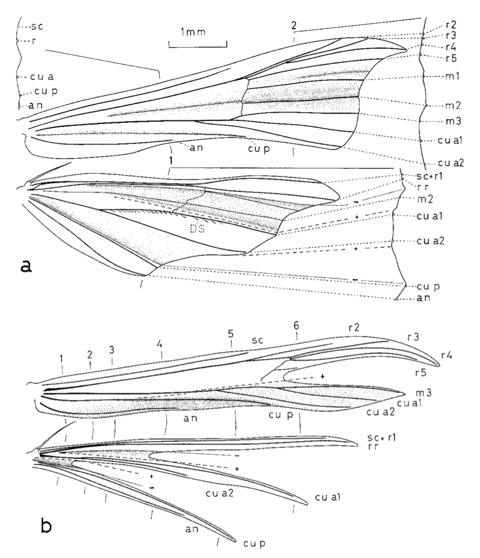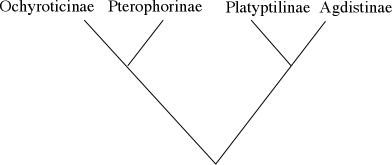Z. Morph. Tiere 77, 127-155
Wing structure in Pterophorids with normal and lobed wings is analyzed with reference to resting and flight behaviour evoked by predator induced stimuli and related to the resting position of the wings, the modes of wing folding, wing marking and typical biotopes. The resting position and folding of the wings in Pterophorids are basically different from those in other moths, as is shown by comparison with Ephestia (Pyralidae) and a noctuid moth. Folding of the wings is a precondition for the development of the family-specific scent scales on the veins on the underside of the hind wings. On the basis of comparative morphology it seems likely that the structure of lobed wings derives from wing folding. The different venation of the plumate lobes indicates that folding has led to cleft wings on two independent occasions. Wing folding is more pronounced in species that live in sparsely vegetated areas. In species indigeneous to areas of abundant vegetation, forewings are generally no longer foldable. Folding of the hind wings, however, is always at least partly realized in these species, as a protection against volatility for the scent scale area. The absence of folding in the forewings is generally associated with conspicuous disruptive pattern. Adaptive coloration is strictly confined to parts that are exposed while the insect is in the resting position. The trend towards wing lobation has continued independently of signs of folding. Economy of material and energy is suggested as the main reason, as the investigation by Norberg (1972) has shown no special flight characteristics. There is no correlation between phyletic time of origin of lobes and depth of fissures. The Pterophorids are able to give different responses to mechanical stimuli according to mode and intensity; slight tactile stimuli evoke immediate flight, while agitation induces apparently passive immobility characterized in fact by active clinging and balancing. Outstretched wings and hindlegs combined with constant readiness to react to tactile stimuli characterize the Pterophorids as quick starters, while rolled or folded wings, concealment coloration and stubborn maintenance of the resting position characterize them as phytomimetic creatures. Thus their appearance can be interpreted as a compromise of protective adaptation evolved to avoid two different groups of predators -- arthropods and birds. The development of lobed wings in the pterophorid plume moths can be assumed to be the result of a process influenced by several interacting selective factors.

The plumes of the split wings can be derived from the foldings of the rolled wings of the unsplit wings within two different sister groups:
The Evolution of the split wings probably occurred two times independently: 1 (a) Ochyroticinae (b) Pterophorinae; 2 (a) Agdistinae, (b) Platyptilinae


Probable independent parallel evolution of the split wings in Pterophoridae. Cladogram based on larval traits (from Wasserthal 1970).

